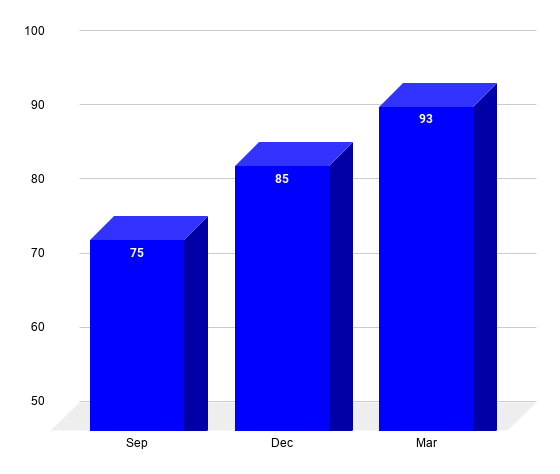STATISTICS TUTORING
Since 2005, we’ve helped students improve their confidence and grades in statistics.
We’re especially proud of the fact that other educators (teachers and professors) and high profile members of the Princeton University Administration trust us with their children’s academic success and recommend our services to others.
We have a 15+ year track record of supporting students in AP Statistics, College-Level Statistics, and more.
How Does It Work?
- Free Consultation – We learn more about your child
- A Perfect Tutor Match – Our team thoughtfully matches you with an amazing 1:1 statistics tutor
- Progress Tracking – Stay in the loop with detailed progress reports after every session
Available Online or In-Person
- Online – Over the past decade, we’ve successfully helped students all over the world using Zoom, virtual whiteboards, and other technologies.
- In-Person – Locally in the Princeton, NJ area
100% Satisfaction Guaranteed
- Experience You Can Trust – Near-perfect ratings, 50,000+ hrs of tutoring experience, and 500+ happy reviews
- Not completely satisfied with a session? Let us know, and we’ll make it right or refund the unused sessions.

What parents say about our Statistics tutors
Our team includes award-winning Princeton University undergrads and Master’s/PhD graduates who are rigorously screened and are extremely effective at communicating the material.
A quick “case study”:
The father of a graduate student at Rider University contacted us at the beginning of the spring semester because his daughter was having trouble with the Statistics class in her MBA program.
It was her first statistics class and she was afraid she would not be able to grasp the concepts because she came from an arts background and was not very analytical.
We matched her with Biyang, a graduate of Princeton University with a Master’s degree in Social Work from the University of Chicago and one of our statistics specialists.
Here is what we heard from the family after they completed their sessions:
“It was a great help to have you on board for Kate.
These concepts were very challenging for her and her health was not the greatest going into the course so it created an extra challenge.
The course is now completed as Kate finished her final test today.
We appreciate your efforts and would recommend Princeton Tutoring for sure.”
We receive messages like these every week.
We regularly track progress
Progress reports are shared after every session so you always know what’s going on.
A Real-Life Example:
Student: Kathryn
Tutor: Biyang
Subject(s): AP Statistics
Date: 02/23/2020
Time Tutored: 17:00 – 18:00
Next Scheduled Session: Fri, 02/28 4:45 PM (Online via Zoom)
Material Covered:
Today we are reviewing for the CH 9 test, which is on hypothesis testing.
The idea of inference is that we are using a formal process to compare our observed data and results with a hypothesis, of which we are testing the validity. This claim is a statement about a population parameter, either a proportion or a mean.
A null hypothesis is the original claim that we believe in, which represents “no difference,” written as Ho, while our alternative hypothesis is the new claim that we are trying to find evidence to prove. Prior to our test, we determine a significance level,, also called alpha. The concept is that given our null hypothesis is true, what are the chances that we would get a result in our experiment that is very different from the null? If our p value is less than our pre-decided alpha, then we say that we have evidence to REJECT the null hypothesis. Our conclusion is that either we 1. reject Ho or 2. FAIL to reject Ho.
The concept of a Type I and Type II error is as follows: Imagine that we create a square with 4 quadrants. The labels at the top indicate our conclusion – either reject or fail to reject the null. To label our rows, which represents the truth about a population, first is that Ho is true, and second is that Ha is true. In quadrant I, If we reject Ho when it’s actually true, we made a Type I error – aka when we put an innocent man in prison. Type II happens when we fail to reject Ho, when Ha is actually the truth. This is like when we fail to convict a criminal. In different experiments, the consequence of one type of error may be greater than the other.
Then we discussed the concept of power. Power is the probability that we DO NOT make a type II error, meaning that it’s p(we reject H0| Ho is false). THis is when we make the right decision. We used a visual explanation when we say that on the left is a sampling distribution with p=0.8, while a left normal distribution has p = 0.11. These 2 graphs will intersect within a certain range. To increase power, we can also increase alpha, which makes sense because increasing alpha makes it easier to reject Ho, which also means that we have a greater chance of making the right choice when Ho is false. However, this decision will also increase our Type I error, which is equal to alpha.
Another way is to increase the sample size, which reduces variability, and in general is good to make our results more valid and reliable.
Remember that a Z test is used for proportions and t-test for means.
To remember the steps in problem-solving, you can think about PHANTOM:
P – determine our Parameter of interst
H – determine our hypothesis
A – assess for the assumptions – check for normal, independent, and random
N – Name our test – ie one sided, 2 sided, z vs t
T – use the formula to find the Test statistic
O – Obtain the p value
M – get our mantra, or our conclusion.
Regarding matched pairs design, in the example of testing whether caffeine withdrawal increases depression, we find take one set of subjects for caffeine and another set for the placebo, and we match them with similar demographics and characteristics. We use the difference of placebo-caffeine to create the sample which we will conduct our hypothesis test. This way, we can treat the experiment as a one-sample test.
Additional Comments:
I definitely think that understanding statistics in context is very helpful. A lot of this is being able to look at a problem, determine the factors most important to us, and to design a test based on our prior knowledge, our goals, and resources.
Please ask questions whenever you need to!
Also, it’d be helpful if you can let me know before hand main points to discuss, or if you just need to go over everything. This way, I can decide to offer targeted info, or just review all the powerpoints in order
Assignments for Next Week:
Next session is to prep for CH 10 test, on Friday, 2/28, at 5:45 PM EST, for 1 hour.
Please give me a min. 24-hr heads up for changes! Good to see you again!

How is your child performing in Statistics?
LEARN HOW WE CAN HELPAddresses common student issues
A deep understanding of the subject matter allows us to personalize our approach.
Why is Statistics important?
Statistics often takes a backseat to Calculus in high school.
However, most students will find more real-world applications of Statistics than Calculus.
Furthermore, you’ll end up using Statistics more than you think in college level courses (e.g. sociology, psychology, etc…)
Why do some students struggle with Statistics?
Students we’ve helped with statistics are usually taking AP Statistics, which may not necessarily be offered at their school. We’ve also helped older students refresh their knowledge of statistics to pass other courses needed for their master’s or other advanced degrees.
The core of statistics is the analysis and interpretation of data, which can confuse many students. And some students have a good working knowledge of the material, but simply struggle with how to use their new graphing calculators.
Let’s Get Started
We’ve produced consistent results over the past 15 years by combining a deep and nuanced understanding of the material, truly world-class tutors, and exceptional customer service.
What else differentiates us?
- Smaller boutique company
- Obsessive attention to quality
- Never any high pressure sales tactics
- Trusted resource with a strong reputation
We’d love to learn more about your student and see how we might be able to help!
TALK TO JESSICA